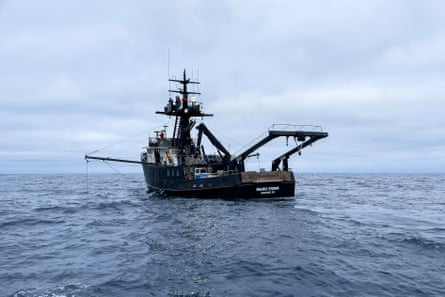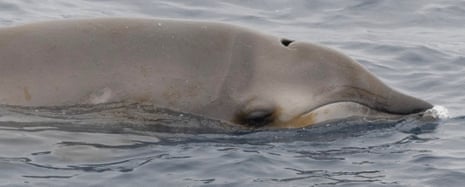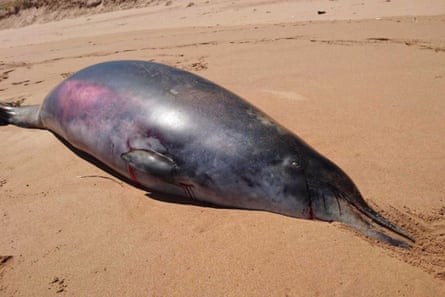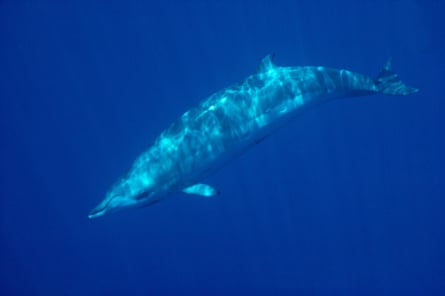It was an early morning in June 2024 and along the coast of Baja California in Mexico, scientists on the Pacific Storm research vessel were finishing their coffee and preparing for a long day searching for some of the most elusive creatures on the planet. Suddenly a call came from the bridge: “Whales! Starboard side!”
For the next few hours, what looked like a couple of juvenile beaked whales kept surfacing and disappearing until finally Robert Pitman, a now-retired researcher at Oregon State University, fired a small arrow from a modified crossbow at the back of one of them.
The tip carved out a small chunk of skin the size of a pencil eraser. It was this that would later prove to the scientists onboard that they were seeing a species that had never before been seen in the wild: a gingko-toothed beaked whale.
“I can’t even describe the feeling because it was something that we had worked towards for so long,” says Elizabeth Henderson, a researcher at the US military’s Naval Information Warfare Center and lead author of the resulting paper published in Marine Mammal Science, who was also there that day. “Everybody on the boat was cheering because we had it, we finally had it.”

The discovery had been five years in the making. Since 2020, Henderson and her colleagues from Mexico and the US had been tracking a group of whales producing a distinctive call, tagged as BW43, which they initially thought was Perrin’s beaked whale, another species that had never been seen in the wild.
The team returned to the same spot for three years, first on a sailing boat, then on a chartered Mexican fishing boat, without any luck. Then in 2024, they teamed up with Oregon State University and set out on its research vessel, which proved to be key to their success. The ship towed an array of hydrophones to listen to underwater sounds, and had an observation deck with high-powered binoculars capable of spotting whales hundreds of metres away.
When it comes to finding beaked whales, such hi-tech aids are an absolute necessity. There are 24 known species, but apart from a few, very little is known about them.

They are the deepest-diving mammals on Earth, spending most of their lives in the oceans, only coming up for air for a few minutes at a time, usually far away from coastlines. They are notoriously shy and easily frightened when approached by a boat. Many species have only been described based on dead animals washing ashore and new species are still being discovered, the last as recently as 2021.
“The Society for Marine Mammalogy has a list of 94 accepted species of cetaceans,” says Pitman. “A quarter of those are beaked whales, but most people have never even heard of them. These are the largest, least-known animals left on the planet.”
But learning more about them is crucial. These whales are especially sensitive to military sonars, which interfere with their foraging, and in some cases cause them to ascend too fast, suffering fatal injuries akin to decompression sickness in scuba divers. Knowing where these whales live can help mitigate the potential harm of sonar by avoiding military training in important beaked whale habitats.

The scientists’ discovery off the Mexican coast that day in June nearly did not happen. Before the crew could scoop the arrow from the surface of the water, an albatross swept in and started to peck at the prized piece of evidence. In panic, the scientists and crew start shouting, some throwing their bread rolls from breakfast to distract or chase away the opportunistic thief.
“In hindsight, it is very funny, but in the moment it was very stressful,” says Henderson.
Finding ginkgo-toothed beaked whales near Mexico was a big surprise – from stranding records, they had often been found washed up on the other side of the Pacific Ocean, on the shores of Japan. The researchers analysed existing acoustic databases for BW43, the now-confirmed call of ginkgo-toothed beaked whales, and found that these animals probably lived off the shores of California and northern Baja California.
“There were two strandings on the west coast of North America previously, but they had always been assumed to have been anomalous – animals that washed ashore, or were sick,” says Henderson. “But now we know that that’s not true and that they actually occupy these waters year-round.”

There are many more beaked whale calls out there without a known source, as well as several species with no known call, and no sightings at sea. So a key focus of research over the last few years has been to match whale calls to species, which will enable scientists to build maps of the animals’ distribution from acoustic data – the only way to track such elusive species.
With a personal bucket list of seeing every whale species on the planet, and now standing at an impressive 90 out of 94, Pitman has tracked down several few elusive animals. But he now thinks Perrin’s might be the hardest to find. There have only been six known strandings, all along the coast of California and all in a heavily decomposed state.
“I think those are just vagrants. It’s someplace else, and we are not quite sure where to go look for this thing,” he says.


.png) 2 hours ago
6
2 hours ago
6

















































